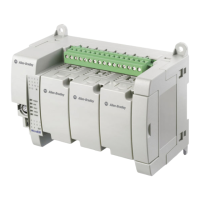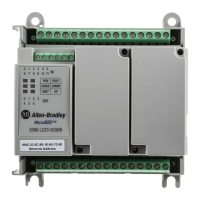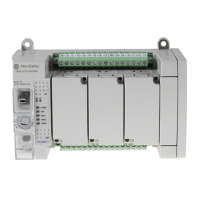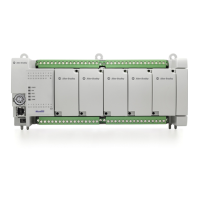Publication 1763-UM001E-EN-P - June 2015
Connecting to Networks via Ethernet Interface 219
Ethernet Connections
TCP/IP is the mechanism used to transport Ethernet messages. On top of
TCP, Ethernet/IP protocol is required to establish sessions and to send the
MSG commands. Connections can be initiated by either a client program
(RSLinx application) or a processor.
The client program or processor must first establish a connection to the
MicroLogix 1100 to enable the MicroLogix 1100 to receive solicited messages
from a client program or another processor.
In order to send an outgoing message, the MicroLogix 1100 must first establish
a connection with the destination node at a specified IP address on the
Ethernet network. A connection is established when a MSG instruction
executes and no previous connection exists.
When a MSG instruction executes, the MicroLogix 1100 checks to see whether
a connection has been established with the destination node. If a connection
has not been established, the MicroLogix 1100 attempts to establish a
connection of the peer type.
The most common wiring for RJ45 cables is the
"straight through" cable which means that pin 1 of
the plug on one end is connected to pin 1 of the
plug on the other end. The straight through RJ45
cable is commonly used to connect network cards
with hubs on 10Base-T and 100Base-Tx networks.
On network cards, pair 1-2 is the transmitter, and
pair 3-6 is the receiver. The other two pairs are not
used. On hubs pair 1-2 is the receiver and 3-6 the
transmitter. It may be best to wire your cables with
the same color sequence. In this cable layout, all
pins are wired one-to-one to the other side. The pins
on the RJ45 connector are assigned in pairs, and
every pair carries one differential signal. Each line
pair has to be twisted.
In small network where only two computers have to
be connected, a "cross over" RJ45 cable is necessary,
where the transmit and receive lines on both RJ45
connectors are cross connected. The color coding for
the cross over RJ45 cable have been defined in the
EIA/TIA 568A standard. In a cross-over cable layout,
you should remember that one end is normal, and
the other end has the cross-over configuration.

